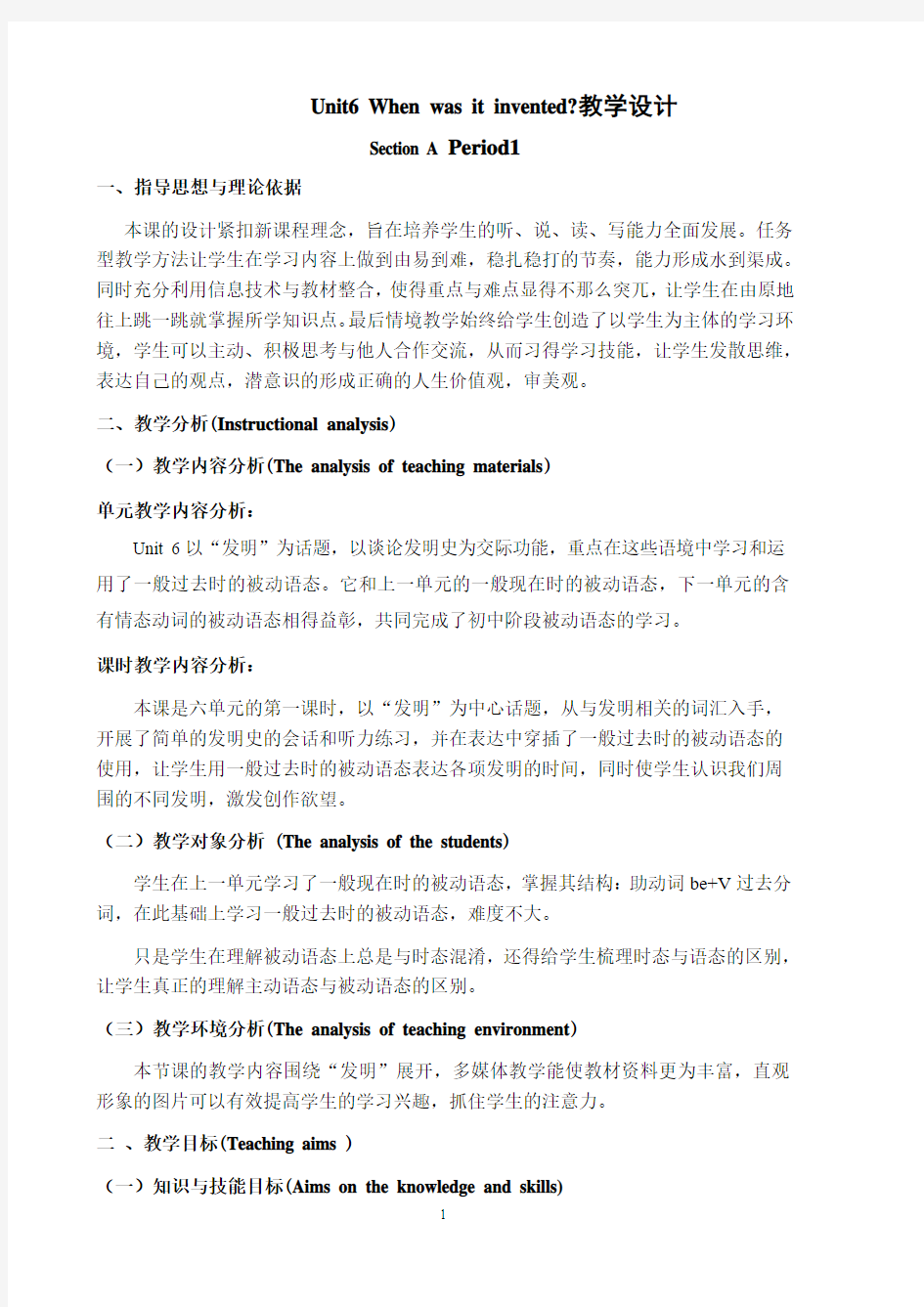

Unit6 When was it invented?教学设计
Section A Period1
一、指导思想与理论依据
本课的设计紧扣新课程理念,旨在培养学生的听、说、读、写能力全面发展。任务型教学方法让学生在学习内容上做到由易到难,稳扎稳打的节奏,能力形成水到渠成。同时充分利用信息技术与教材整合,使得重点与难点显得不那么突兀,让学生在由原地往上跳一跳就掌握所学知识点。最后情境教学始终给学生创造了以学生为主体的学习环境,学生可以主动、积极思考与他人合作交流,从而习得学习技能,让学生发散思维,表达自己的观点,潜意识的形成正确的人生价值观,审美观。
二、教学分析(Instructional analysis)
(一)教学内容分析(The analysis of teaching materials)
单元教学内容分析:
Unit 6以“发明”为话题,以谈论发明史为交际功能,重点在这些语境中学习和运用了一般过去时的被动语态。它和上一单元的一般现在时的被动语态,下一单元的含有情态动词的被动语态相得益彰,共同完成了初中阶段被动语态的学习。
课时教学内容分析:
本课是六单元的第一课时,以“发明”为中心话题,从与发明相关的词汇入手,开展了简单的发明史的会话和听力练习,并在表达中穿插了一般过去时的被动语态的使用,让学生用一般过去时的被动语态表达各项发明的时间,同时使学生认识我们周围的不同发明,激发创作欲望。
(二)教学对象分析 (The analysis of the students)
学生在上一单元学习了一般现在时的被动语态,掌握其结构:助动词be+V过去分词,在此基础上学习一般过去时的被动语态,难度不大。
只是学生在理解被动语态上总是与时态混淆,还得给学生梳理时态与语态的区别,让学生真正的理解主动语态与被动语态的区别。
(三)教学环境分析(The analysis of teaching environment)
本节课的教学内容围绕“发明”展开,多媒体教学能使教材资料更为丰富,直观形象的图片可以有效提高学生的学习兴趣,抓住学生的注意力。
二、教学目标(Teaching aims )
1)能掌握以下单词及短语:heel,scoop,electricity,style,shoes with special heels,hot
ice-cream scoop,runs on electricity,be used for;
2)掌握重点句子:
What was the telephone invented?
I think it was invented in 1876.
What is it/are they used for?
It’s/They’re used for …
3)掌握重点语法:
一般过去时的被动语态结构:was/were +V过去分词
一般现在时,一般过去时和一般过去时被动语态的区别
(二)过程与方法目标(Aims on process and methods)
1.情景教学法
2.任务教学法
3.Pair work
4.Group work.
(三)情感态度与价值观目标(Aims on the emotion and value)
使学生认识我们周围的不同发明,学会感恩,激发创作欲望。
三、教学重点和难点(Key and difficult points)
(一)教学重点:
1)能掌握以下单词及短语:heel, scoop, electricity ,style, shoes with special heels, hot ice-cream scoop, runs on electricity, be used for;
2)掌握重点句子:
What was the telephone invented?
I think it was invented in 1876.
What is it/are they used for?
It’s/They’re used for …
3)掌握重点语法:
一般过去时的被动语态结构:was/were +V过去分词
(二)教学难点:
一般现在时,一般过去时和一般过去时被动语态的区别
四、教学过程(Teaching procedure)
[设计意图]开篇点题,开门见山的形式让学生明确本单元的语法项目,初步感知一般过去被动语态的构成:was/were +V过去分词,学生心里对学习重点有所了解。
[设计意图]通过让学生谈论常见食物的发明先后,让学生感知一般过去时的被动语态的表达方法,为后面的学习作了铺垫。
Step 3.Listening1b,1c(6 minutes)
1.Pre-listening
Now read the years . 1876,1885,1927,1971
2.While-listening
Now listen to 1b and match the inventions with the years.
3.After listening
pair work..
A: When was the telephone invented?
B: I think it was invented in 1876.
[设计意图]听力练习对1a进行的答案核对,让学生准确感知一般过去时被动语态的表达,并且趁热打铁,针对单元标题,做了对话练习,使学生对一般过去时被动语态构成及表达加深印象。
[设计意图]将听、说、读、写的任务结合起来不仅锻炼的学生的语言综合运用能力,还巩固了学生对被动语态的学习、识记和运用的能力。
Step 5 Grammar (5 minutes)
1.Ss read these following sentences
[设计意图]语法总结,突破难点。
Step 6 Exercises (10 minutes)
1.根据句意及所给提示完成句子
1)The bus will run on ________ (电) and solar power.
2) You can try this blouse on. It is the newest _______ (款式)。
3)The knives ______ _______ _______ (被用来做) cutting things.
2.单项选择
1)The two shirts are similar in _______ ,but different in price.
A.style
B.sign
C.height
D.interest
2) Our school library is very beautiful and it ______ last year.
A.builds
B.built
C.is built
D.was built
3.按要求完成下列句子,每空一词。
1)Mom washed these clothes last night.(改为被动语态)
These clothes _______ ______ by Mom last night.
2) Were these vegetables grown by your father last year?(补全肯定回答)
_______ they ______ .
3).The book was bought last week.(改为否定句)
The book _____ ______ last week.
4).Coal is used for cooking meals.(对画线部分提问)
_______ _______ coal _______ for?
Step 7 Consolidate and Emotion education(2minutes)
There are many useful things in the world.They help us a lot in life.You can see inventions all around us,from TV to car,from food to clothing.We should say nobody can live without them.These inventions make our life easier and more comfortable.We should thanks the inventors and we should study hard and try to invent more useful inventions.
[设计意图]让学生懂得感恩,激发学习动力和创作欲望。
Step 8.Summary:(2minutes)
In this class, we’ve learned new key words and phrases: heel,scoop,electricity,style, shoes with special heels, hot ice-cream scoop,runs on electricity,be used for.And we’v e learned how to express passive voice by listening and making conversations.
[设计意图]总结本节课所学的主要内容,学会归纳总结。
Step 9.Homework(2minutes)
1.Make two conversations about 1c and 2c.
2.Write a passage about the four inventions of China.(papermaking
technology,typography,compass,gunpower) Introduce when they were invented and what they are used for..
[设计意图]作业分层设计,让学生自由选择,巩固本节所学内容。
五、板书设计:
Unit6 When was it invented?
Section A Period1(1a-2c)
Words and phrases:
heel, scoop ,electricity, style,shoes with special heels,
hot ice-cream scoop,runs on electricity, be used for
Target language:
What was the telephone invented?
I think it was invented in 1876.
What are they used for? They’re used for…
一般过去时的被动语态结构:was/were +V过去分词
六、教学反思:
优点:
1.本节课我利用多媒体展示图片,情景教学的学习策略,复习巩固旧词汇,认识学习新词汇,为文本学习作好铺垫。
2.通过pairwork,groupwork等口语交际活动,遵循学生认知规律,由易到难,使学生对一般过去时被动语态的结构熟练掌握,从听到说,从大量的输入,口语操练巩固,随后进行输出。
3.用对比分析的方式让学生掌握一般现在时,一般过去时,一般过去时的被动语态的区别。首先,让学生区分清时态,随后就不同时态的句子分析语态,尤其对于“发明”这个话题,只强调发明的用途,发明时间。不强调谁是发明者。让学生认清被动语态的应用模式。
4.在每个任务栏中,我都考虑的学生的认知水平和能力,让学生由输入——巩固操练——输出——再巩固操练。让学生乐学易学,轻松掌握知识,同时也注重培养看学生的听、说、读、写的能力。把学生进行分组分列练习,既照顾到每个学生的水平,也考虑到小组合作探究能力的培养,正确运用小组评价机制,让学生真正动起来。
不足:
1.英语口语不够熟练,在评价学生的回答时方法单一。
2.活动中对程度低的学生兼顾不到。
通过以上总结,我对以后教学将做以下改进:
1.搞好自身提高,培养英语素养,增强英语口语训练,给学生创造更好的英语
课堂氛围。
2.照顾到每一个学生,利用“兵教兵”的方法,不让任何一个学生掉队。
3.继续发挥课堂设计的特点,吃透教材,把知识点与培养能力整合到一起,让学
生学习起来更轻松。
4.有效利用小组评价机制,调动每个学生的学习积极性,同时培养小组合作能力。
5.课堂上主动培养学生学习主动性,学生要自己大胆说、写、读,精准的练。